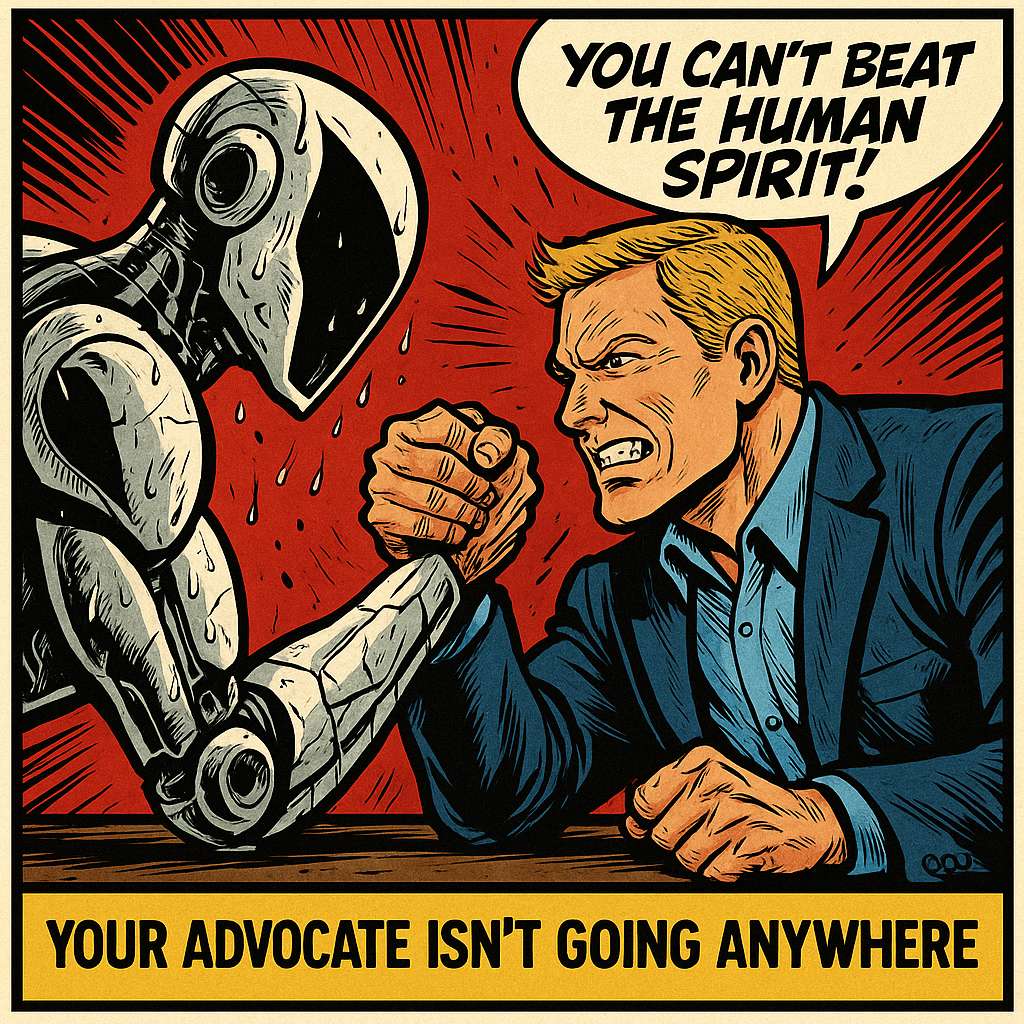Why the robots can’t replace the humans fighting for your workers’ comp claim
A client we’ll call Maria Gonzalez thought she was losing her mind. After fifteen years cleaning office buildings, her shoulders screamed every time she lifted her arms. Her doctor said it was work-related. Her physiotherapist agreed. The MRI confirmed torn rotator cuffs in both shoulders.
But WCB still said no. Just a cold denial letter, stamped and filed.
Three months later, we got Maria’s claim approved. Same medical evidence. Same injuries. Same bureaucracy.
So what gives?
It wasn’t the facts. It was the story.
The Fear
Everywhere you look, artificial intelligence is eating jobs. Chatbots answer customer service calls. Algorithms trade stocks. AI writes news articles and diagnoses diseases. So when injured workers hear that computers can now summarize medical reports and draft legal documents faster than any human, a reasonable question emerges: Is my WCB advocate next?
The short answer is no. But the long answer is more interesting and nuanced.
What Computers Do Best
Picture a vast library containing every Workers’ Compensation Board policy, every court decision, every medical journal article about workplace injuries. Now imagine someone who can read that entire library in minutes, cross-reference everything, and spit out summaries on command. That’s basically what AI does now.
Need to know what Policy 03-02 says about pre-existing conditions? AI’s got it. Want to compare how different provinces handle psychological injury claims? Done in seconds. Looking for recent Appeals Commission decisions about chronic pain? Here’s your comprehensive list, sorted by date and relevance.
This is revolutionary for the grunt work of advocacy practice. The hours advocates used to spend digging through policy manuals and case law databases can now be compressed into minutes. Documents get organized automatically. Deadlines get tracked. First drafts of standard letters appear with a few keystrokes.
But here’s what the efficiency gains miss: Workers’ comp cases aren’t won in policy manuals. They’re won in the spaces between the rules.
The Human Story
We compel WCB to humanize its own policy. Left alone, the system reduces workers like Maria Gonzalez to diagnostic codes and claim numbers. On paper, she was simply “a 52-year-old custodial worker with bilateral shoulder impingement and degenerative changes.” But that description stripped her of the life she actually lived — a mother who raised three children while holding down two jobs, spending fifteen years climbing ladders and reaching overhead to clean fixtures that were never designed with cleaners in mind. By reframing the same medical facts as a human story, we compelled decision-makers to see beyond sterile file language and confront the real consequences of her injury. Policy may be written in abstraction, but our role as advocates is to ensure it is applied in flesh-and-blood reality.
The Contradiction Game
Not every denial contains contradictions. But the ones that do can make or break a case if you know where to look.
Take the so-called “independent” medical examination. Workers know it is rarely independent and often hostile. AI can flag when the doctor contradicts himself between page three and page seven of his report. Human judgment sees the deeper contradiction, not between his sentences but between his conclusion and the sixteen workplace photos that show an employee forced into ergonomics no body could withstand.
Or look at the employer who swears no light-duty work exists, while their website simultaneously advertises positions that align almost exactly with the injured worker’s restrictions. AI can surface the inconsistency. An advocate knows when to present it immediately and when to hold it back until it will have maximum effect in a hearing.
The machine detects the cracks. The human turns them into leverage. And that’s the key difference between a denial that stands and a denial that collapses.
The Trust Factor
Here’s what no algorithm can replicate: sitting across a table at Tim Hortons while a 56-year-old electrician breaks down describing how he can’t pick up his grandson anymore.
Workers’ compensation claims happen to real people at the lowest point in their life. They’re in physical pain. They’re financially desperate. They’re scared about their future. They’ve often been treated like liars by the unfeeling system.
They don’t just need someone who understands Policy 04-01 for instance. They need someone who believes them. Someone who gets professionally indignant on their behalf. Someone who can translate their lived experience of disability into language that bureaucracy can’t ignore.
You can’t download empathy. You can’t algorithm your way into the kind of trust that makes you comfortable revealing the panic attacks you’ve been hiding, or the marriage that’s falling apart because chronic pain has changed who you are.
Reading the Room
WCB hearings are theater as much as they are quasi-legal, and these days the stage is usually virtual. The panel members — most often lawyers, occasionally joined by other professionals — appear in little boxes across the top of a screen, while the injured worker often sits alone at a kitchen table or in a spare bedroom, trying to juggle documents and nerves without the comfort of face-to-face connection. The power dynamic is still there, only now it is amplified by technology.
An experienced advocate reads this virtual room like a poker player reads tells. Is the chairperson glancing at another monitor because they are running behind, or because they have already made up their mind? Is a panelist leaning closer to the camera because they are engaged, or because they are skeptical? When the employer’s lawyer interrupts, is it strategic posturing or genuine concern?
These micro-cues still shape macro decisions. Push harder on this point. Back off on that one. Adjust the tone. Adapt the approach on the fly. In persons or on a screen, these real-time tactical choices require human intuition, the kind no artificial intelligence can process.
The Bureaucratic Maze
Workers’ Compensation Boards are massive bureaucracies with personalities as distinct as small nations. Alberta’s WCB operates differently from Ontario’s WSIB, which operates differently from WorkSafeBC. Each has its own culture, its own blind spots, its own internal politics.
More importantly, each individual case manager, medical advisor, and appeals officer brings their own biases, experiences, and pet peeves to the process. Some respond to detailed medical arguments. Others want simple human stories. Some are impressed by extensive legal and Appeals Commission research. Others are annoyed by it.
AI can tell you what the official process says. But it takes years of practice to know that Case Manager Johnson tends to approve psychological claims more readily than Case Manager Smith, or that DRDRB specialist Chen always asks about pre-existing conditions even when they’re not relevant.
This institutional knowledge isn’t written down anywhere. It’s accumulated through hundreds of conversations, dozens of hearings, and countless informal interactions with system insiders. It’s the difference between knowing the rules and knowing how the game is actually played.
The Dirty Work
Nobody talks about this part, but advocacy often comes down to the quiet, behind-the-scenes work that decides cases. Sometimes it means sitting down with your doctor to make sure their report doesn’t just list a diagnosis, but actually explains how your injury affects your day-to-day life. It can mean correcting unclear medical language before WCB uses it against you. It can mean piecing together years of medical notes and job records so your story is clear and impossible to ignore.
It also means preparing you to tell your story in a way that makes sense to decision-makers, or drawing out details you didn’t think mattered until someone asked the right question. It might mean walking you through what to expect at a stressful assessment, or reminding a psychologist that a single phrase can be the difference between approval and denial.
This isn’t flashy work. It is slow, detailed, and often invisible. But it is exactly where cases are won. Because a computer will never sit across from your doctor and explain how WCB policy interprets their report. It will never calm you down when the system feels overwhelming. And it will never earn the kind of trust that makes you comfortable enough to share the things you’ve been holding back. That still takes a human advocate who is willing to do the hard work for you.
The Strategy Layer
Every workers’ comp case involves choices: Which medical expert to hire. Which policy arguments to emphasize. Whether to settle or fight to the end. Whether to focus on the original injury or the employer’s failure to accommodate. Whether to make this about medical causation or aggravation of a preexisting condition.
These decisions can’t be made by consulting a database or following a flow chart. They require judgment calls based on incomplete information, assessment of risks and benefits, and understanding of how this particular client’s personality and circumstances interact with this particular system’s tendencies.
An AI might calculate that similar cases succeed 73% of the time when they emphasize medical causation versus 68% when they focus on accommodation failures. But it can’t factor in that this client becomes visibly angry when discussing their claim history—anger that might antagonize an appeals panel—or that the employer in this case has such a terrible safety record that accommodation arguments play into a larger narrative of corporate indifference.
What This Means for You
If you are an injured worker trying to make your way through the workers’ compensation system, here is what the rise of AI really means: your advocate now has better tools. The hours once lost digging through policy manuals or formatting documents can now be spent where it actually counts, on strategy, on building your case, and on telling your story in a way that decision-makers cannot ignore.
Yes, the bureaucrats processing your claim will also get AI tools. That might help them move routine files a little faster. But it does not change the fact that the hard calls, the ones that decide whether you are believed or denied, are still made by human beings. In some ways, those tools only make the system colder and more mechanical, making it even easier for you to be treated like a claim number instead of a person.
That is why the core truth has not changed. You still need someone in your corner who knows both the rules and the reality, who can cut through bureaucracy and connect with people, who refuses to let your story be reduced to a line of code. Technology may make the paperwork faster, but it will never replace the advocate who fights to keep you human in a system that too often forgets you are one.
The Irreplaceable Human Element
We got Maria’s claim approved not because of new technology, but because we understand something fundamental about WCB. Decisions are framed in the language of policy and law, but those rules are interpreted by people. And interpretation is shaped by how well the story of an injured worker is told.
Maria’s file on its own looked scattered: a handful of medical appointments, an inconsistent work history, limited English, and frustration that sometimes came out the wrong way. We helped turn that into a narrative appeals officers could connect with. Not a file number, but a dedicated employee who quite literally reached too high for too long because that was what the job demanded—until her body could no longer do it.
That isn’t just policy or legal knowledge. It is the human skill of framing facts so they are understood in context. It is advocacy as translation, making sure policy is applied to real people rather than abstract codes. And it’s precisely what artificial intelligence cannot replicate.
The robots may be coming for a lot of jobs, but they are not coming for the people who fight for injured workers when the system fails them. Because in the end, workers’ compensation isn’t merely about policy and procedure.
It is about people. And people need other people in their corner.
Your WCB advocate is not going anywhere.


